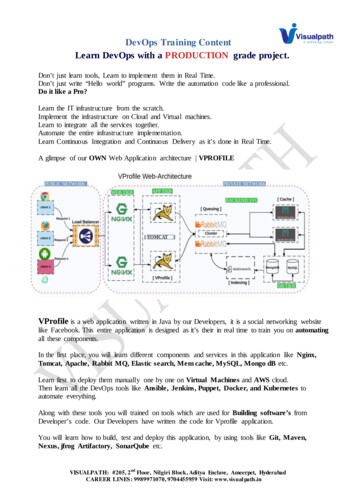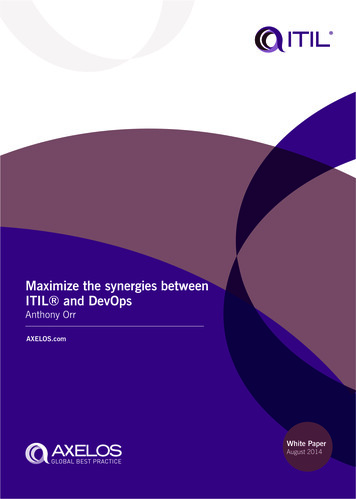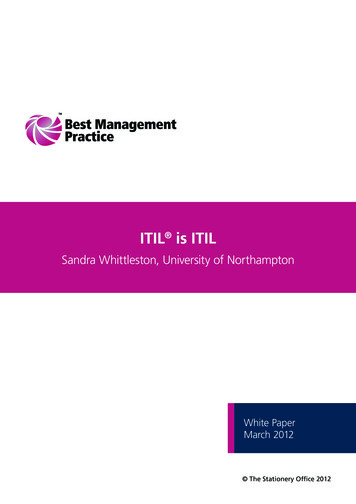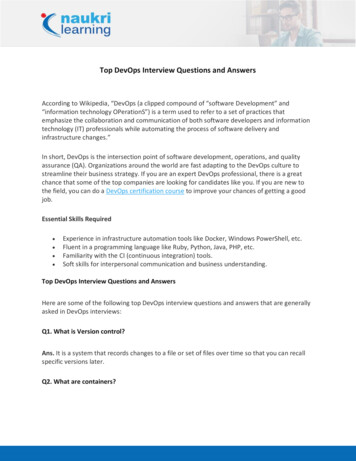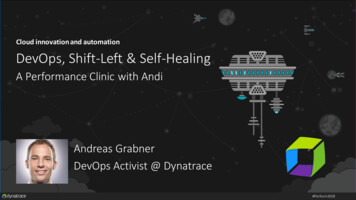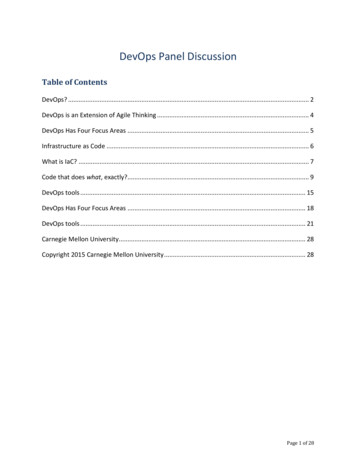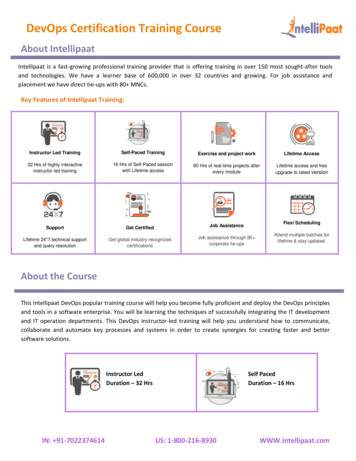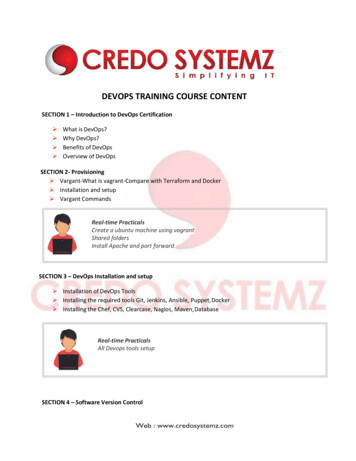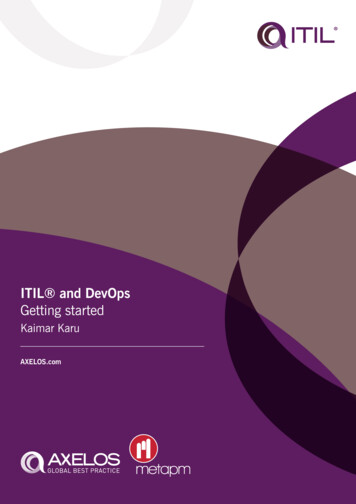
Transcription
ITIL and DevOpsGetting startedKaimar KaruAXELOS.com
ContentsExecutive summary3Introduction3Part 1: Context and background5Understanding the current challenge5How did we end up here?6Thinking in services7Part 2: Getting started with DevOps10The DevOps stables: horses and unicorns10The three ways: enabling and adopting DevOps practices12Part 3: Evolving IT operations19Operations as a platform19Afterword21Appendix A: A subset of DevOps concepts and practices21Appendix B: ITIL Guiding Principles22Appendix C: Recommended additional reading23About the author24Reviewers24About AXELOS25Trade marks and statements25 Copyright AXELOS Limited 2017
ITIL and DevOps13Executive summaryThe DevOps movement presents IT service management (ITSM) professionals with an invaluableopportunity to enhance the support they offer the business by increasing value for the customer throughimproved services due to better service management practice. At the same time, organizations fullyimmersed in the world of DevOps have begun to understand the value of the service mind-set, with itsimmense positive impact on customer value and its benefits to the bottom line of the business.Roughly speaking, three types of organizations are looking to leverage DevOps practices: the ones born inthe world of apps, cloud computing, and automation by default; the ones successfully leveraging newtechnologies and practices to rebuild their existing IT capabilities; and the ones just starting their journeyfrom the mean-time-between-failure (MTBF) world to the mean-time-to-restore (MTTR) world. There’s agood chance your organization is in this third category. The majority of organizations are! In which case,this guidance paper is here to help you.While the DevOps philosophy encourages collaboration with the whole organization, including the end- toend service lifecycle, DevOps practices have been most telling within IT Operations, specifically ITcapabilities. This is also where the quickest wins for ITSM are today – and the highest customer value.This paper explores the context of ITSM in modern-day organizations. It covers the improvement ofpractices over time and the challenges we are facing today. It then aligns the wider scope of ITSM tospecific DevOps practices, and highlights key improvement opportunities, including tips on getting started.Not everything covered in this paper is new but never before has it been possible to perform ITSM work soefficiently.The last section of the paper provides a new view on the role of IT operations in the modernorganization; a role that allows IT operations to fully utilize their expertise and become trusted advisors andtrue business enablers.2IntroductionIncreased organization-wide awareness of the benefits of DevOps practices, including board-levelvisibility, has allowed ITSM professionals to approach their service improvement initiatives with therequisite support from their stakeholders.DevOpsDevOps (a portmanteau of development and operations) is a philosophy and a movement focusingon organization-wide collaboration to support the delivery of value to the organization and itscustomers. The drivers for DevOps can be seen in the increasing awareness and acceptance ofthe complexity of business and technology environments, the rapid developments within IT thatmake it possible to ‘do the right thing right’, and the overall acknowledgement of the crucial rolethat people play within this and the value that they bring. These aspects are all aligned with theITSM mind-set.1In organizations that have embraced the DevOps philosophy, and have introduced improved ways ofworking, it is the IT operations team that has so far reaped the most benefit from the emergence of DevOps.This is because DevOps practices strengthen the connection with, and the feedback loops between, thedevelopment of a service and its operation once it has been released. Copyright AXELOS Limited 2017
ITIL and DevOps4IT operationsThe phrase ‘IT operations’, used extensively throughout this paper, signifies a combination ofITSM capabilities predominantly residing in the service design, service transition, and serviceoperation stages of the service lifecycle. It covers processes like availability management,change management, release and deployment management, service asset and configurationmanagement, event management, incident management, and problem management. This is alsowhere DevOps practices intersect with ITSM the most.DevOps practices leverage various Lean techniques, such as Kanban, to improve the quality of work.They bring together the people who are developing individual components of the service and the peoplewho will run the service, to ensure maximum collaboration and a smooth transition from one to theother.LeanThe core idea is to maximize customer value while minimizing waste. Simply, lean meanscreating more value for customers with fewer resources.A lean organization understands customer value and focuses its key processes to continuouslyincrease it. The ultimate goal is to provide perfect value to the customer through a perfect valuecreation process that has zero waste.To accomplish this, lean thinking changes the focus of management from optimizing separatetechnologies, assets, and vertical departments to optimizing the flow of products and servicesthrough entire value streams that flow horizontally across technologies, assets, and departmentsto customers.2IT operations, DevOps helps to address the age-old problem of being presented with a service, ora component of a service, that is unsuitable for the job for which it is intended. When softwaredevelopment and IT operations teams work together, the whole lifecycle of a new service, application, orimprovement initiative tends to run smoother, cheaper, quicker, with a net result of a better quality, betterfit for purpose, better fit for use product, and a more satisfied customer.Adopting DevOps practices is a transformation initiative for most organizations, as is any large scaleimprovement. You cannot ‘implement’ DevOps. It is a journey. The journey requires specific enablers tobe put in place before DevOps practices can be fully adopted. Many of these enablers are outside the IToperations domain. They cover the whole service lifecycle, the whole value stream involved in deliveringvalue to customers through fit-for-use and fit-for-purpose services.For some organizations, this seems overwhelming, maybe even impossible to achieve. Organizations findstarting this journey to be a significant challenge, and they find it difficult to know where to begin, orhow. Organizations that have IT systems older than, say, 10 years cannot simply switch over to new waysof working, to fully leverage cloud computing and/or agile Software Development practices.Yet, many organizations have already achieved success with adopting DevOps practices. This paperaims to make it easier for organizations to get started. Copyright AXELOS Limited 2017
ITIL and DevOps5In Part 1 of this paper, we will explore the journey that organizations have taken when movingfrom reactive fire-fighting IT processes to a service-based approach of delivering value usingITcapabilities, and the challenges this has presented. We will also explore the alignment of softwaredevelopment and ITSM, and introduce key DevOps concepts in the context of ITSM.In Part 2 we will go into more depth to explore specific DevOps practices, and how to bestleverage these to improve an organization’s ITSM capabilities. In addition, we will look at waysthe service mind-set brings additional value to organizations who are adopting DevOpspractices.Finally, in Part 3, we will finish with a suggestion for how IT operations teams could rethinktheir role in the wider context of the organization, to become true business enablers for thewhole service delivery value chain. Copyright AXELOS Limited 2017
ITIL and DevOps6PART 1: Context and background3Understanding the current challengeIn an environment where IT has to focus on keeping the lights on, ready to enter fire-fighter mode ata moment’s notice, many IT professionals are overloaded with a never-ending stream of work.‘Dark matter’, as it is sometimes referred to, the value and extent of which they find hard to quantify. Intrying to address this, organizations often struggle to go beyond the implementation of reactive processes;the adoption of an end-to-end service management mind-set is more than they can hope for. For manyorganizations, the focus of improvements has been limited to a few capabilities. These are described in ITIL Service Operation (service desk, incident management, and reactive problem management), ITIL ServiceTransition (change management and configuration management), and ITIL Service Design (servicecatalogue management and availability management). These are often in isolation from one another andfrom the rest of the value chain, which can lead to local optimizations that have limited value for theorganization as a whole.The situation is further complicated by the misconception that ITIL – a commonly used frameworkfor ITSM – needs to be ‘fully implemented’, and that its benefits will only be seen if every aspect ofevery process is in place as described in the ITIL lifecycle suite books, and each role is mapped ontoa corresponding, separate, job position. This would be a Herculean task at the best of times, andan unnecessary one at that. Under the influence of these misconceptions, it is no wonder that manyorganizations have not been able to fully leverage the ITSM benefits.Initiating improvements in isolation from the wider organization can prompt many challenges. Therehas been a rapid emergence of new technologies and practices in the past decade. Both softwaredevelopment and IT operations have improved their ways of working. The trouble is, they have improvedin ways that now need significant effort to re-align. Partially due to the difference in the way they view andaddress change, the misalignment of their practices has grown considerably over time.The pain caused by this misalignment has given rise to the DevOps movement. DevOps is underpinnedby a philosophy that transforms the way IT professionals think about the stability and resilience ofthe systems they manage, as well as about their job roles in the end-to-end view of value flow. The‘development vs. operations’ mind-set is disappearing, albeit slowly, as both sides have come to understandthat they are on the same team and are working towards the same goals.It is important to remember that some often quoted metrics with regards DevOps are not necessarily wherethe focus should be. The number of software deployments per day can provide interesting Copyright AXELOS Limited 2017
ITIL and DevOps7insights, but the capability to deliver value faster is what matters. From a similar viewpoint, using cloud services isnot about the cloud per se, but about leveraging the technology available today to rebuild existing IT infrastructureinto something much more resilient, improving specific work practices in the process, and supporting the wholeorganization by doing so.In the traditional IT operations world, some common DevOps practices might seem incompatible with existingstrategic objectives and ways of working, especially when it comes to planning, service deployment, and riskmanagement. While not entirely novel for high-performing organizations, some of these practices would have beenunfeasible for most organizations in the past. The opportunities presented by today’s technology have made itachievable for most.For example, the provisioning and delivery of computing power for cloud-based solutions has now beencommodified and often automated. Hardware is treated less like a collection of artisanal artefacts and more likeelectricity – ‘pets vs. cattle’, as it is often referred to. Agile software development practices, the capabilities ofmodern IT infrastructure management, and automation have made it possible for IT professionals to truly becomebusiness enablers. IT is no longer there just to keep the lights on. Instead, it provides great value and significantadvantages for the organization and their customers over their competitors. Furthermore, as this value has becomeapparent throughout the organization, non-IT departments are increasingly open to including IT capabilities as partof their strategic assets, rather than as a support function. In other words, true ITSM capabilities are now attainablefor most organizations, if they are interested, and motivated to do so.The challenge for most organizations is to understand the practicalities of how to make it work. It is important tounderstand how technology, including cloud computing, has changed over time. The cloud of today has progressed,in its current form cloud computing is an enabler and a prerequisite for most DevOps practices. The DevOpsmovement has helped to combine the ‘what’, ‘why’, and ‘how’ of leveraging IT for organization-wide value delivery,focusing strongly on the ‘how’, and therefore providing an invaluable resource for ITSM professionals.4How did we end up here?For software development, change has always been the norm. For IT operations, change has always meant additionalstress on people and systems.Some time ago, when the IT departments of most organizations were struggling with fragile in-house infrastructure,the primary focus of IT operations teams was to keep the systems running with little time left for other tasks.The maintenance of the production environment – the most visible part of the IT infrastructure – required a lot of(manual) work.On the software development side, both the functional and non-functional requirements kept changing throughoutthe design and development phases, which led to mid-flight adjustments to code and (sometimes significant)changes to the infrastructure. This in turn led to various ad hoc changes – patches - in the production environmentfor both software and hardware, which were deployed by IT operations. This made clean redeployment virtuallyimpossible, and led to further ad hoc changes when something broke, increasing the fragility even further.High cost of hardware and long procurement times prohibited the utilization of identical development, test, andproduction environments. As a result, the code that was released had often been tested with a smaller data-set,using considerably lower utilization levels, and completely different infrastructure. If it had been tested at all, thatis. The demand for swifter software delivery was already there, and often the only way to speed things up was todecrease testing time. We have all experienced the results of these shortcuts.For developers, it was almost impossible to know how their code would perform in the production environment, soguesses had to be made. Long deployment cycles removed developers from the frontline, and tracking the reasonsfor a failed release six months after the code was delivered was nearly impossible. Similarly, it was difficult to predictthe software’s demand on hardware capacity for (at least) a tolerable user experience, leading either to seriouscapacity issues or significant overspend on hardware.Organizations, suffering from these underperforming IT systems, were not happy. Work was undertaken to identifycommon successful practices for developing and managing IT systems, and proposing new ways of working where theorganization’s existing practices didn’t lend themselves to significant improvements. Copyright AXELOS Limited 2017
ITIL and DevOps8On the IT operations side, this work focused mainly on two aspects: infrastructure and customer service. The former coveredboth the hardware and system management software, and the latter dealt with the two-way interaction with the customer.On one hand, it was clear that IT had to better understand the organization’s requirements for new IT systems, and on theother, user experience of IT systems had to be improved.In the 1990s, software development professionals were actively searching for viable alternatives to the waterfall approach, newways of working to support incremental development methods that could allow applications to deliver value more promptly andmore frequently. While some of these practices had first appeared in the 1970s, they had not yet entered the mainstream. Thesearch led to the introduction of extreme programming, and the rise of various other agile methodologies.At the same time, IT operations professionals were looking to improve the customer’s overall experience with IT systems. Theobjective was to allow business units to focus on their core functions without the need to familiarize themselves with thespecifics of various technologies, and without being impacted by the performance issues of IT systems.Rather than exposing the ‘back of house’ directly to the end users, IT systems (including all hardware and software) werepackaged into services, and IT’s ‘front of house’ (in the form of a Helpdesk, or a Service Desk) took on the daily interactionwith the user. This field of expertise, dealing with IT services, became known as ITSM, and was codified in the secondversion of IT Infrastructure Library – or ITIL for short.In the coming years, it became abundantly clear that focusing on IT operations was not enough to design, deliver, andsupport services. The experience of both public and private sector organizations around the world had shown that ITcapabilities had to be aligned with the organization’s strategy earlier than the execution or maintenance stages. Anupdated understanding of what IT means for a modern organization was required.When ITIL underwent a major revision in 2007, and was refreshed in 2011, dropping the long form of IT InfrastructureLibrary, it mapped proven IT practices onto a service lifecycle approach. This covered the strategy, design, transition, andoperation of services, enabled by continual service improvement – or kaizen as it is known in the world of Lean. Theupdated approach promoted an end-to-end service view, including the development of the software components of theservice, and focused on leveraging IT capabilities to enhance the overall business value, rather than IT functioning in itsown little world, ‘doing IT’.The growing complexity of technology and practices in both IT operations and software development kept most professionalsfocused on their domain, and rarely was there a chance to look up and focus on the whole value stream, or seriously analyzethe value the customer received from IT.Over the past decade, the advancements in IT have made it significantly easier to align the efforts of software developmentand IT operations. Cloud computing, drastically changing the cost and delivery times for additional hardware capacity andsoftware updates, has simplified many previously laborious activities. Both sides of the historical development/operationsdivide have realized that the only way forward is through close collaboration.To make full use of these new capabilities, it is important to review existing ITSM processes and procedures in ordertoensure IT operations don’t become a bottleneck in delivering additional value to the organization. For IT operationsprofessionals, this opportunity for revising how work is done is a relief – much of the once-required, perhaps evenpreviously preferred bureaucracy (or ‘scar tissue’, as Adrian Cockcroft refers to it) has become unnecessary. Effort canbe re-focused on what matters today and what will provide a competitive advantage tomorrow. Large sections of the ITILguidance that were once difficult to adopt, e.g. automating standard changes and enabling continual improvement, are nowwithin the capabilities of most organizations. This is where various DevOps practices can be successfully leveraged.5 Thinking in servicesIn the early days of ITSM, the main discourse was on ‘IT and business alignment’, with the focus on ensur
Not everything covered in this paper is new but never before has it been possible to perform ITSM work so efficiently. The last section of the paper provides a new view on the role of IT operations in the modern organization; a role that allows IT operations to fully utilize their expertis
